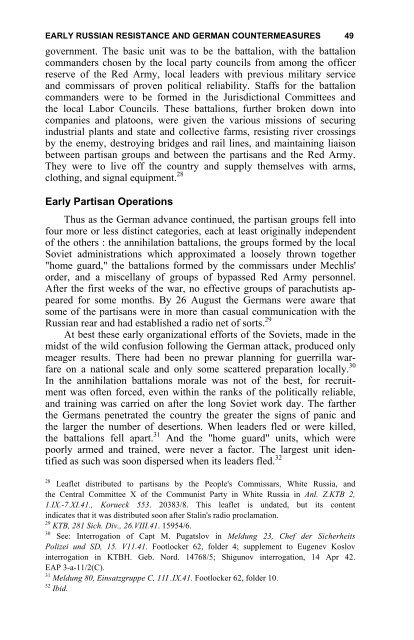the soviet partisan movement 1941-1944 by edgar m. howell
the soviet partisan movement 1941-1944 by edgar m. howell
the soviet partisan movement 1941-1944 by edgar m. howell
Create successful ePaper yourself
Turn your PDF publications into a flip-book with our unique Google optimized e-Paper software.
EARLY RUSSIAN RESISTANCE AND GERMAN COUNTERMEASURES 49<br />
government. The basic unit was to be <strong>the</strong> battalion, with <strong>the</strong> battalion<br />
commanders chosen <strong>by</strong> <strong>the</strong> local party councils from among <strong>the</strong> officer<br />
reserve of <strong>the</strong> Red Army, local leaders with previous military service<br />
and commissars of proven political reliability. Staffs for <strong>the</strong> battalion<br />
commanders were to be formed in <strong>the</strong> Jurisdictional Committees and<br />
<strong>the</strong> local Labor Councils. These battalions, fur<strong>the</strong>r broken down into<br />
companies and platoons, were given <strong>the</strong> various missions of securing<br />
industrial plants and state and collective farms, resisting river crossings<br />
<strong>by</strong> <strong>the</strong> enemy, destroying bridges and rail lines, and maintaining liaison<br />
between <strong>partisan</strong> groups and between <strong>the</strong> <strong>partisan</strong>s and <strong>the</strong> Red Army.<br />
They were to live off <strong>the</strong> country and supply <strong>the</strong>mselves with arms,<br />
clothing, and signal equipment. 28<br />
Early Partisan Operations<br />
Thus as <strong>the</strong> German advance continued, <strong>the</strong> <strong>partisan</strong> groups fell into<br />
four more or less distinct categories, each at least originally independent<br />
of <strong>the</strong> o<strong>the</strong>rs : <strong>the</strong> annihilation battalions, <strong>the</strong> groups formed <strong>by</strong> <strong>the</strong> local<br />
Soviet administrations which approximated a loosely thrown toge<strong>the</strong>r<br />
"home guard," <strong>the</strong> battalions formed <strong>by</strong> <strong>the</strong> commissars under Mechlis'<br />
order, and a miscellany of groups of <strong>by</strong>passed Red Army personnel.<br />
After <strong>the</strong> first weeks of <strong>the</strong> war, no effective groups of parachutists appeared<br />
for some months. By 26 August <strong>the</strong> Germans were aware that<br />
some of <strong>the</strong> <strong>partisan</strong>s were in more than casual communication with <strong>the</strong><br />
Russian rear and had established a radio net of sorts. 29<br />
At best <strong>the</strong>se early organizational efforts of <strong>the</strong> Soviets, made in <strong>the</strong><br />
midst of <strong>the</strong> wild confusion following <strong>the</strong> German attack, produced only<br />
meager results. There had been no prewar planning for guerrilla warfare<br />
on a national scale and only some scattered preparation locally. 30<br />
In <strong>the</strong> annihilation battalions morale was not of <strong>the</strong> best, for recruitment<br />
was often forced, even within <strong>the</strong> ranks of <strong>the</strong> politically reliable,<br />
and training was carried on after <strong>the</strong> long Soviet work day. The far<strong>the</strong>r<br />
<strong>the</strong> Germans penetrated <strong>the</strong> country <strong>the</strong> greater <strong>the</strong> signs of panic and<br />
<strong>the</strong> larger <strong>the</strong> number of desertions. When leaders fled or were killed,<br />
<strong>the</strong> battalions fell apart. 31 And <strong>the</strong> "home guard" units, which were<br />
poorly armed and trained, were never a factor. The largest unit identified<br />
as such was soon dispersed when its leaders fled. 32<br />
28<br />
Leaflet distributed to <strong>partisan</strong>s <strong>by</strong> <strong>the</strong> People's Commissars, White Russia, and<br />
<strong>the</strong> Central Committee X of <strong>the</strong> Communist Party in White Russia in Anl. Z.KTB 2,<br />
1.IX.-7.XI.41., Korueck 553. 20383/8. This leaflet is undated, but its content<br />
indicates that it was distributed soon after Stalin's radio proclamation. <br />
29<br />
KTB, 281 Sich. Div., 26.VIII.41. 15954/6.<br />
30<br />
See: Interrogation of Capt M. Pugatslov in Meldung 23, Chef der Sicherheits<br />
Polizei und SD, 15. V11.41. Footlocker 62, folder 4; supplement to Eugenev Koslov<br />
interrogation in KTBH. Geb. Nord. 14768/5; Shigunov interrogation, 14 Apr 42.<br />
EAP 3-a-11/2(C). <br />
31<br />
Meldung 80, Einsatzgruppe C, 11I .IX.41. Footlocker 62, folder 10.<br />
32<br />
Ibid.
















